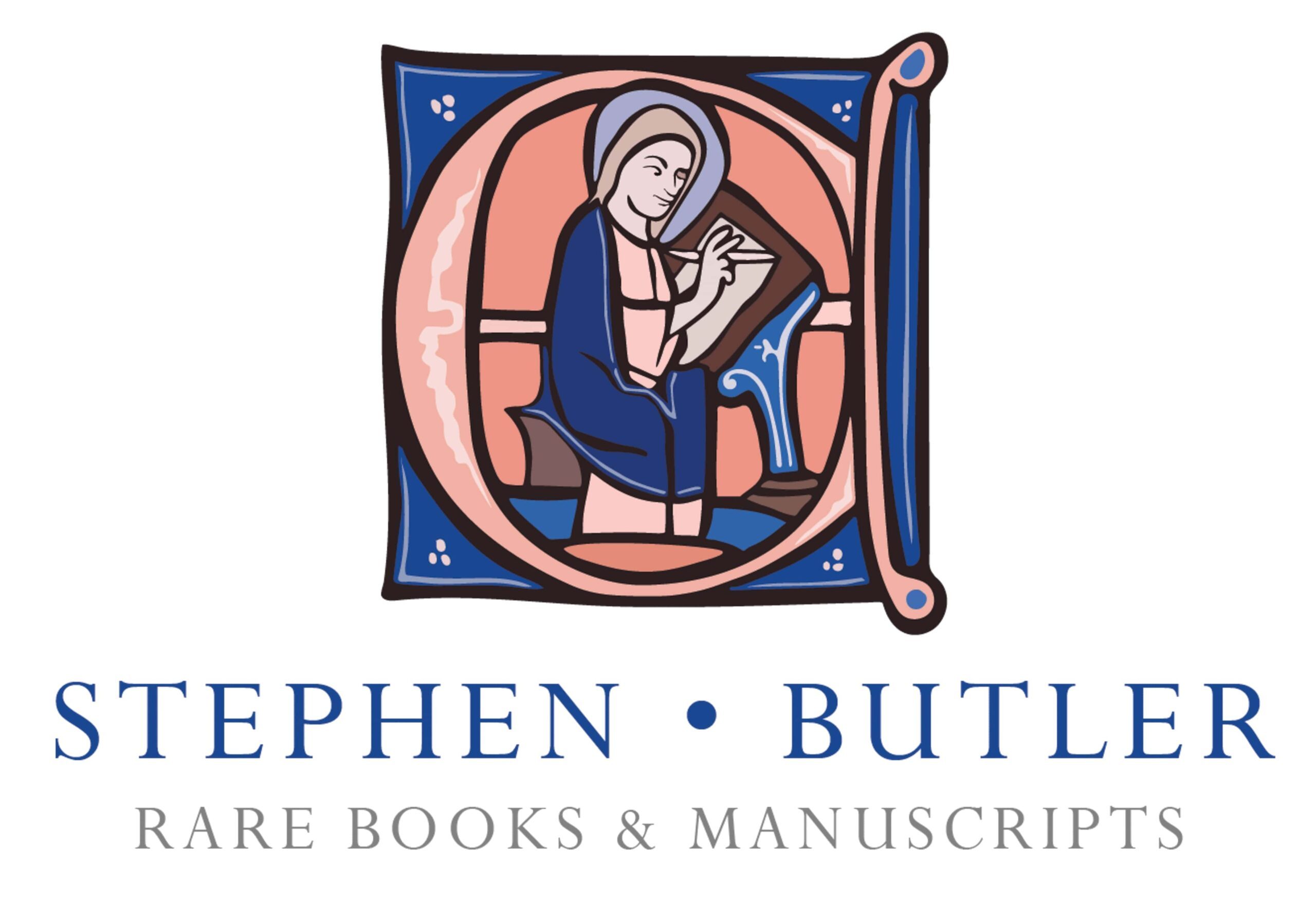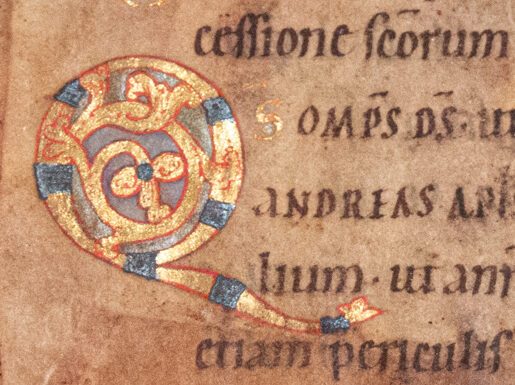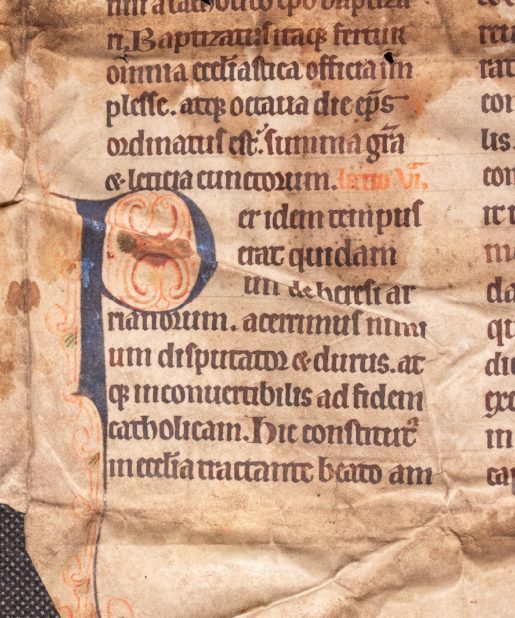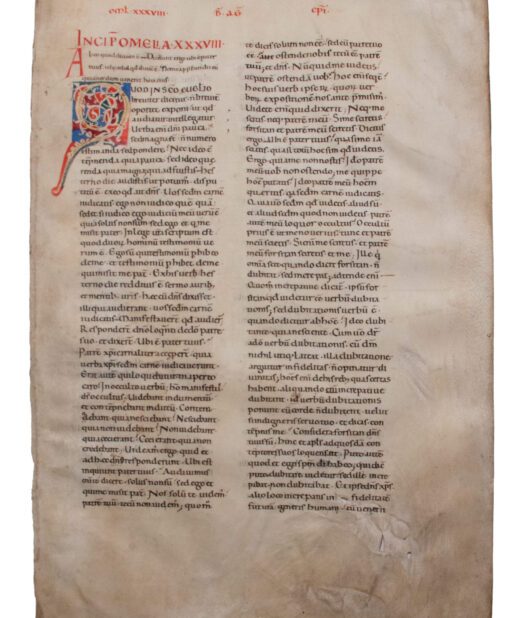Two half-leaves from a Sacramentary, in Latin, sumptuously illuminated manuscript on vellum [Germany, late 11th century or early 12th century]
£6,000.00
Two half-leaves from a Sacramentary, in Latin, sumptuously illuminated manuscript on vellum
[Germany, late 11th century or early 12th century]
265 × 180mm, the upper half of one leaf, and the lower half of another, lacking the lowermost line and margin, up to 14 lines each, the rubrics in gold majuscules, written in a fine early Romanesque bookhand the text comprising Masses for the Third to Sixth Sundays after Pentecost, and for 29–30 November, decorated with one-, two- and three-line initials in gold, infilled with colour, the largest also with silver and with simple vegetal forms outlined in red and multi-coloured interstices; recovered from use as the front and back pastedowns in a binding, with consequent damage and staining from the tanned leather turn-ins, a handsome survival of a destroyed manuscript of exceptional luxury
Text
The upper part of a leaf has Masses for the Third to Sixth Sundays after Pentecost, and the lower part of a leaf has Masses for 29–30 November:
Upper Recto: starting in the prayer for the Third Sunday; “nichil sanctum multiplica super nos …”, and ending in the Secret for the Fourth: “Oblationibus quesumus domine placare susceptis & ad te”.
Verso: starting in the Secret for the Fifth Sunday: “[obla]tiones famulorum famularumqeu tuarum …”, and ending with the prayer for the Sixth: “… nutritia custodias. Per dominum.”
Lower recto: starting with the prayer for the feast of St Saturninus (29 November), “Deus qui nos beati saturnini martyris tui …”, with Secret and Postcommunion, followed by the large initial ‘Q’ which introduces the first prayer on the vigil of the feast of St Andrew: “Quesumus deus ut beatus Andreas apostolus tuum …”, followed by the Secret.
Verso: the prayer for feast of St Andrew (30 November), lacking the first few words, “Andreas apostolus extitit predicator et rector …”, with two Secrets and Postcommunions.
From a nearly-thousand-year-old manuscript of unusual splendour. Chrysography, writing in gold, is rare outside imperial commissions, and echoes the script of the Carolingian golden Gospel Books.
Be the first to review “Two half-leaves from a Sacramentary, in Latin, sumptuously illuminated manuscript on vellum [Germany, late 11th century or early 12th century]” Cancel reply
Product Enquiry
Related products
C12th - C13th manuscripts
C12th - C13th manuscripts
Elegant English Early Gothic Script from late C12th Passionale – Paulinus of Milan
C12th - C13th manuscripts
C12th - C13th manuscripts
Huge C12th bifolium of St Augustine’s Tractate 94 on St. John’s gospel.
C14th -C16th manuscripts
C12th - C13th manuscripts
Beautiful painted white vine initial, Augustine’s Commentary on John’s Gospel, Italy C12th
C12th - C13th manuscripts

![Two half-leaves from a Sacramentary, in Latin, sumptuously illuminated manuscript on vellum [Germany, late 11th century or early 12th century] Two half-leaves from a Sacramentary, in Latin, sumptuously illuminated manuscript on vellum [Germany, late 11th century or early 12th century]](https://butlerrarebooks.co.uk/wp-content/uploads/2024/12/IMG_0268-2.jpg)
![Two half-leaves from a Sacramentary, in Latin, sumptuously illuminated manuscript on vellum [Germany, late 11th century or early 12th century] Two half-leaves from a Sacramentary, in Latin, sumptuously illuminated manuscript on vellum [Germany, late 11th century or early 12th century]](https://butlerrarebooks.co.uk/wp-content/uploads/2024/12/IMG_0269.jpg)
![Two half-leaves from a Sacramentary, in Latin, sumptuously illuminated manuscript on vellum [Germany, late 11th century or early 12th century] Two half-leaves from a Sacramentary, in Latin, sumptuously illuminated manuscript on vellum [Germany, late 11th century or early 12th century]](https://butlerrarebooks.co.uk/wp-content/uploads/2024/12/IMG_0267.jpg)
![Two half-leaves from a Sacramentary, in Latin, sumptuously illuminated manuscript on vellum [Germany, late 11th century or early 12th century] Two half-leaves from a Sacramentary, in Latin, sumptuously illuminated manuscript on vellum [Germany, late 11th century or early 12th century]](https://butlerrarebooks.co.uk/wp-content/uploads/2024/12/IMG_0268.jpg)




![Two half-leaves from a Sacramentary, in Latin, sumptuously illuminated manuscript on vellum [Germany, late 11th century or early 12th century] Two half-leaves from a Sacramentary, in Latin, sumptuously illuminated manuscript on vellum [Germany, late 11th century or early 12th century]](https://butlerrarebooks.co.uk/wp-content/uploads/2025/01/IMG_0351-100x100.jpg)
![Two half-leaves from a Sacramentary, in Latin, sumptuously illuminated manuscript on vellum [Germany, late 11th century or early 12th century] Two half-leaves from a Sacramentary, in Latin, sumptuously illuminated manuscript on vellum [Germany, late 11th century or early 12th century]](https://butlerrarebooks.co.uk/wp-content/uploads/2024/12/IMG_8764-100x100.jpg)
![Commentary on Aristotle, Categoriae, and the same authors translation of Perihermenias BOETHIUS [MS] C.13th Commentary on Aristotle, Categoriae, and the same authors translation of Perihermenias BOETHIUS [MS] C.13th](https://butlerrarebooks.co.uk/wp-content/uploads/2013/08/IMG_8383-515x618.jpg)
![Commentary on Aristotle, Categoriae, and the same authors translation of Perihermenias BOETHIUS [MS] C.13th Commentary on Aristotle, Categoriae, and the same authors translation of Perihermenias BOETHIUS [MS] C.13th](https://butlerrarebooks.co.uk/wp-content/uploads/2013/08/IMG_8379-515x618.jpg)







![The Annunciation to Zechariah, on a bifolium from an Antiphonary, in Latin [Germany or Austria, (mid-?)15th century] The Annunciation to Zechariah, on a bifolium from an Antiphonary, in Latin [Germany or Austria, (mid-?)15th century]](https://butlerrarebooks.co.uk/wp-content/uploads/2021/04/IMG_0977-515x618.jpg)
![The Annunciation to Zechariah, on a bifolium from an Antiphonary, in Latin [Germany or Austria, (mid-?)15th century] The Annunciation to Zechariah, on a bifolium from an Antiphonary, in Latin [Germany or Austria, (mid-?)15th century]](https://butlerrarebooks.co.uk/wp-content/uploads/2021/04/IMG_0769-515x618.jpg)




Reviews
There are no reviews yet.